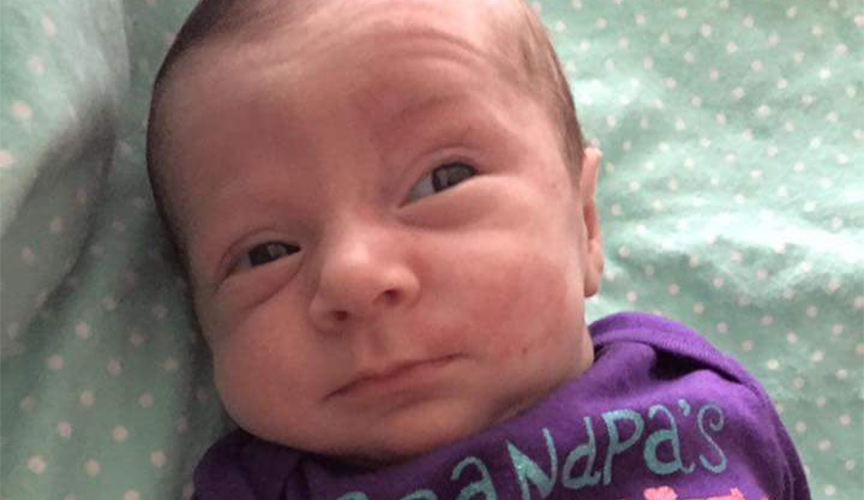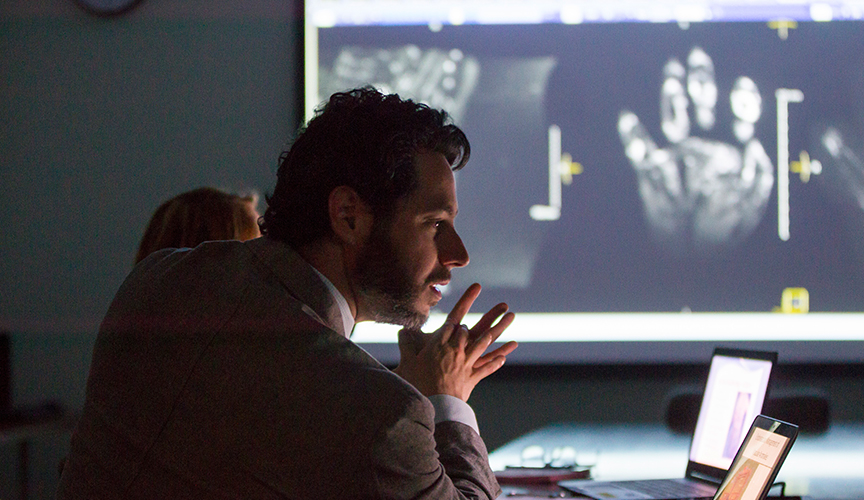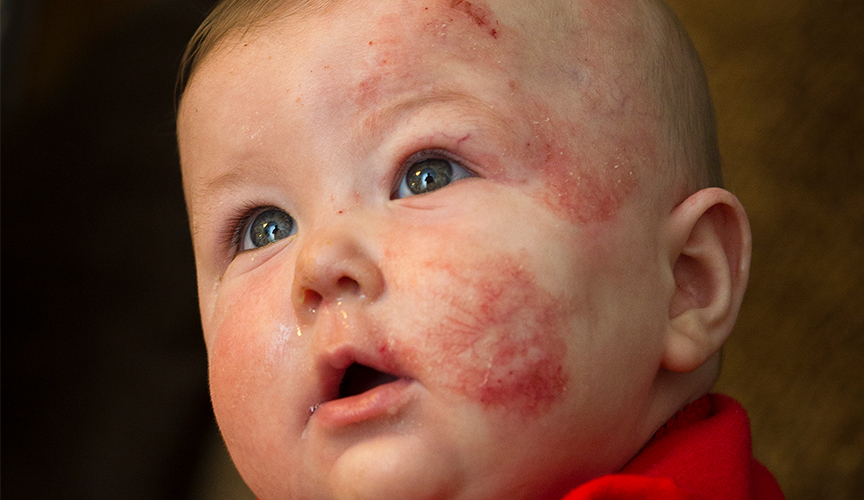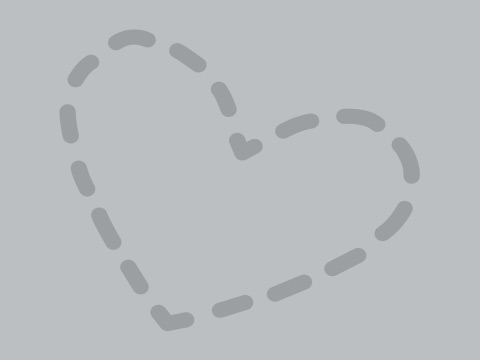On the Mark
Reshaping care for vascular anomalies
Sawyer Dembicky had the lesion when she was born – then just a small, reddish mark on the left side of her face. A birthmark, her parents thought, or maybe bruising from labor and delivery. Her pediatrician called it a hemangioma. The Covington, Tenn., parents were told to keep an eye on it. It would eventually go away with time.
Vascular Anomalies ProgramBy the time Sawyer was 5 weeks old, the lesion had swollen, and a hard lump had begun to develop under her skin. The tumor continued to grow.
“It was red and purple, and you could all these blood vessels,” said Amanda McCorkle, Sawyer’s mom. “Her eye started swelling shut. We wondered what was going to happen to her eyesight.”

In just eight weeks, the lesion had grown behind her eye, slowly pushing it out of orbit and threatening Sawyer’s vision.The family was referred to Le Bonheur Children’s Hospital, where a team of specialists were in place and ready to handle Sawyer’s complex segmental hemangioma and save her eyesight.
The hospital formalized its Vascular Anomalies Center in July 2015 to provide more coordinated care for patients like Sawyer with vascular tumors or malformations – lesions that are often misunderstood and take a team of multidisciplinary specialists to properly diagnose and treat.
More than a birthmark
Vascular anomalies are not uncommon. Many children are born with some sort of vascular birthmark . In the past few decades, though, doctors have learned that sometimes there is much more to these birthmarks than meets the eye.
“The catch-all term that encompasses what we see is vascular anomalies, but it’s a very mixed group of lesions. There’s a broad spectrum,” said Lucas Elijovich, MD, a neuroendovascular surgeon with Semmes-Murphey and a co-director of Le Bonheur’s Pediatric Vascular Anomalies Center.

Caused by abnormally developing blood vessels, vascular anomalies can present on any part of the body and may be composed of veins, arteries, capillaries, lymphatic vessels or a combination. Few of these lesions can be cured – only managed through various treatment options that range from medical therapy to interventional or procedural treatment including embolization and sclerotherapy. Because they are so complex and treatment is often multimodal, these lesions almost always require multidisciplinary collaboration and treatment for the best possible cosmetic or functional outcome.
Such was the case for Sawyer. She needed the expertise of both a pediatric dermatologist and a pediatric ophthalmologist, who worked together to determine the best option for Sawyer’s segmental facial hemangioma and rule out any underlying syndromes often associated with such lesions. And before she had even arrived in clinic, Sawyer’s case was discussed collaboratively by the entire Vascular Anomalies team – a group made up of subspecialists from eight hospital service lines.

A collaborative approach
Bringing together a multidisciplinary team focused on managing these complex lesions has been the primary goal of the Vascular Anomalies Center. Crucial to that approach: a centralized clinic where patients can see all the specialists they need in one setting.
“Historically, it’s been hard to know where to send these patients. Kids might come in to different clinics as their entry point, and then it would be difficult to get all the specialists together needed to provide them with the best management plan,” said Teresa Wright, MD, chief of Pediatric Dermatology at Le Bonheur. Wright, who has spent much of her career treating vascular anomalies, was recruited to Le Bonheur in 2015 to help develop the Pediatric Vascular Anomalies program.
The monthly Vascular Anomalies Clinic is regularly staffed by pediatric dermatology, pediatric surgery, pediatric plastic surgery and interventionalists. Other specialists, including pediatric orthopaedic surgeons, cardiologists, hematologists/oncologists, ophthalmologists, interventional radiologists and otolaryngologists, come to the clinic as needed. Specialists from Le Bonheur’s Fetal Center also come as needed, as some patients’ vascular malformations are diagnosed prenatally. Patients’ care is coordinated by a nurse coordinator who helps schedule patients’ clinic or procedure appointments and guide families through the process.
In the morning of clinic, every subspecialist gathers for a conference to discuss each patient on the schedule. The physicians review all of the patients’ imaging and collaborate.
“Everybody sees an image of the patient that’s been sent over by the parent. Everybody looks at the imaging, so it’s not just one of us making an assessment,” said Pediatric Surgeon Regan Williams, MD, co-director of the program. “And then we talk about the treatment options. What are the risks and benefits of those options? Sometimes we have friendly disagreements, but we really want to be able to give the parents all the information and all the options.”
This focused, collaborative approach has allowed the Vascular Anomalies team to not only weigh all of the treatment options for patients and families – but also to give them an accurate diagnosis and education on their child’s condition. The broad spectrum of vascular anomalies sometimes makes proper diagnosis a challenge.
“We’ve seen many frustrated families who’ve been told multiple different things from multiple different people and don’t really know what to do and or who was right,” said Williams. “If you’ve been told your child has an infantile hemangioma, and it’s going to go away, but then it starts to grow, it can be really concerning for families."
When a new patient is seen in clinic, the core group of specialists visits the patient at once.
“We tell the families, ‘We’ve seen your child’s imaging. We’ve all discussed your child’s case. Here’s what you’re dealing with. Here are your treatment options,’” said Williams.
Parents like Amanda McCorkle appreciate that kind of approach.
“It felt so good to know that all these doctors knew about my child and had talked about what to do,” said Amanda. “When that many people come together just for your baby, it just makes you relieved.”
Measuring outcomes, quality of life
With a coordinated program and centralized clinic in place, Le Bonheur’s Vascular Anomalies program is also focusing on measuring patient outcomes. Patient diagnoses are entered into a database, and outcomes are tracked.
“We’re following patients who’ve received treatment to see how the lesion is responding. We want to determine the best possible way to treat these vascular anomalies,” said Elijovich, who specializes in embolization and sclerotherapy, a procedure that injects a medication directly into the cysts to cause inflammation that allows the lesion to scar and collapse.
The team is also focused on patients’ quality of life, collecting data through patient surveys to determine which therapies are associated with better or worse quality of life.
“Our whole program is really focused on a good experience for families and doing what’s best for them,” said Elijovich.
Vascular Anomalies Leadership
Lucas Elijovich, MD
Director, Neuroendovascular Surgery, Le Bonheur Children’s Hospital
Co-director, Vascular Anomalies Center, Le Bonheur Children’s Hospital
Neuroendovascular Surgeon, Semmes Murphey
Associate Professor of Neurology and Neurosurgery, The University of Tennessee Health Science Center
Regan Williams, MD
Medical Director, Trauma Services
Assistant Professor of Surgery and Pediatrics, The University of Tennessee Health Science Center
Teresa Wright, MD
Chief, Pediatric Dermatology, Le Bonheur Children’s Hospital
Co-director, Vascular Anomalies Center, Le Bonheur Children’s Hospital
Associate Professor of Dermatology, The University of Tennessee Health Science Center













